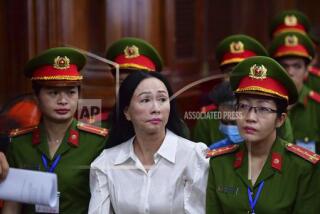Ta Mok, 80; Key Figure in Cambodian Genocide
- Share via
Ta Mok, a Khmer Rouge leader who played a key role in the deaths of an estimated 1.7 million Cambodians in the 1970s, died early today in a Phnom Penh military hospital, where he was awaiting trial on genocide charges.
A frail, white-haired man, Ta Mok was believed to be 80. He maintained to the end that he bore no responsibility for Cambodia’s “killing fields” and that other Khmer Rouge commanders had been the architects and perpetrators of the genocide.
But for years Ta Mok, a nom de guerre, was a feared name in Cambodia. As the second in command of the Khmer Rouge, he and his followers were linked to the elimination of entire villages, to forced labor camps, to mass executions and to torture chambers. Cambodians called him “The Butcher.” The prime minister, Hun Sen, referred to him as the “Hitler of Cambodia.”
Although little is known about his personal life, Ta Mok, whose real name was Chhit Choen, was born into a peasant family in the southern province of Takeo.
Like many poor young Cambodians in the 1930s, he became a Buddhist monk, because pagodas offered food and shelter. He left the monkhood at 16 and in the 1940s joined the resistance movement against the French colonialists.
Unlike other senior Khmer Rouge leaders, such as Pol Pot, Ta Mok never studied abroad and had little use for intellectual issues. He was more comfortable in the jungle than in the city.
His sole ideology was Cambodian nationalism, and he only vaguely grasped the concepts of communism that were the foundation of the Khmer Rouge’s ultra-Maoist revolution.
“When I joined the Communist Party of Cambodia,” he told Nate Thayer of the Far Eastern Economic Review in a 1997 interview, “I did not know what communism was. They told me the party was a patriotic one. That is why I joined the party.”
He also told Thayer that his motivation for becoming a guerrilla was to secure a better life for Cambodian peasants and to free the country from Vietnamese domination.
The Khmer Rouge came to power in April 1975 after defeating the U.S.-backed government of Lon Nol. During the 44 months it ruled Cambodia -- until deposed in 1979 by invading Vietnamese troops -- the Khmer Rouge killed one in every six Cambodians, including much of the middle class, in the name of creating a pure agrarian society free of foreign influence.
After Vietnam’s invasion, Ta Mok, who was Pol Pot’s top lieutenant, fled into the jungle to carry on the guerrilla war, first against Vietnam, then against the new Cambodian government.
He conducted ruthless purges of the Khmer Rouge’s suspected enemies and set up a fiefdom in the northern town of Anlong Veng. U.N. peacekeepers in 1993 blamed him for the slaughter of ethnic Vietnamese, including many women and babies, in a fishing village on the Great Lake.
In 1997, Ta Mok took control of the Khmer Rouge from Pol Pot in a bloody purge. But by then, the movement was dying. Defectors by the hundreds had surrendered their weapons in exchange for a government offer of amnesty.
Pol Pot died in the northern jungle in April 1998, an apparent suicide.
Ta Mok was arrested in March 1999 crossing into northern Cambodia from Thailand and charged with genocide under a law banning the Khmer Rouge.
Over the last few years, Ta Mok’s lawyer said, his client was in declining health after suffering a heart attack.
More to Read
Sign up for Essential California
The most important California stories and recommendations in your inbox every morning.
You may occasionally receive promotional content from the Los Angeles Times.













